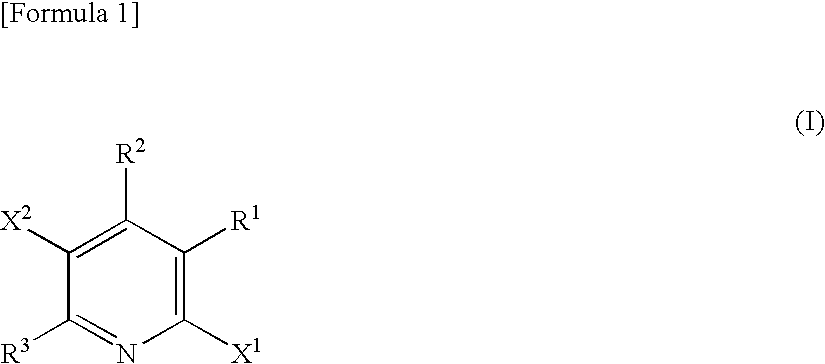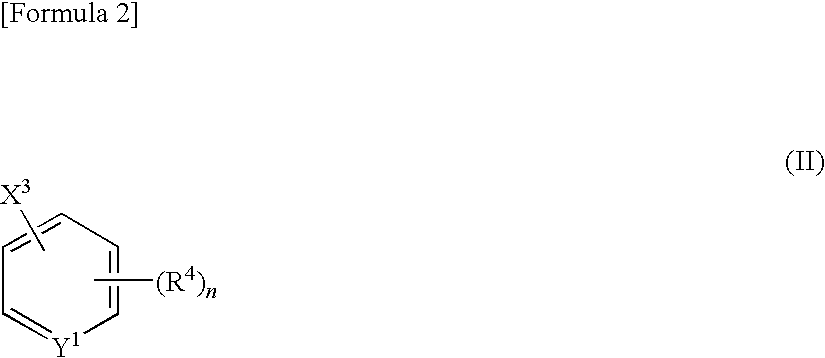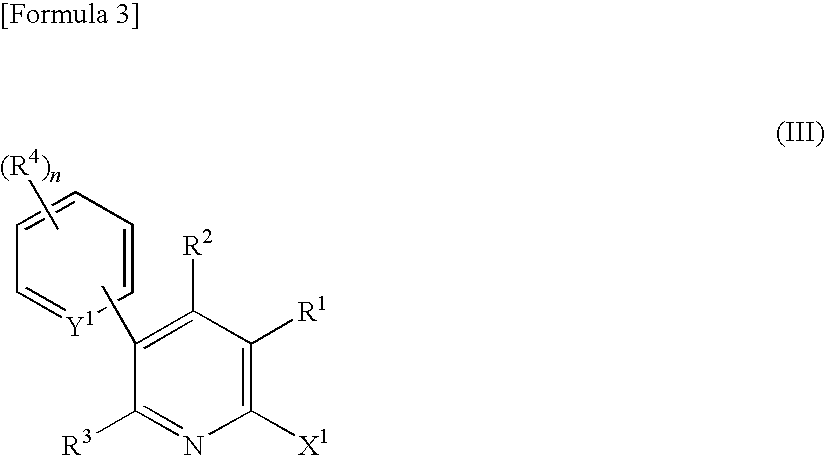Production method of 6-halogeno-3-arylpyridine derivative
a production method and technology of arylpyridine, applied in the field of production methods of 6halogeno-3arylpyridine derivatives, can solve the problems of difficult to separate isomers, inability to achieve industrially advantageous methods, and inability to synthesize 5-pyridylmagnesiumbromide methods,
- Summary
- Abstract
- Description
- Claims
- Application Information
AI Technical Summary
Benefits of technology
Problems solved by technology
Method used
Image
Examples
example 1
Synthesis of 6-chloro-3-phenylpyridine
[0044]In a 300 mL inner volume flask replaced by nitrogen, 30.3 g of tetrahydrofuran solution containing 19.5% by weight of isopropylmagnesium chloride (57.5 mmol as isopropylmagnesium chloride) as a magnesiation reagent was charged, and cooled at 10° C., and then 20 g of tetrahydrofuran solution containing 5-bromo-2-chloropyridine (9.6 g, 50.0 mmol) as a 2,5-dihalogenopyridine derivative (I), was added dropwise in the range of 10 to 20° C. for 1.0 hour. After adding dropwise, the reaction mixture was stirred in the range of 10 to 20° C. for 1.5 hours, and then added dropwise to the solution of tetrahydrofuran (20 g) containing bromobenzene (7.9 g, 50.0 mmol) as a halogenoaryl derivative (II), and [1,1′-bis(diphenylphosphino)ferrocene]dichloropalladium(II) (0.20 g, 0.25 mmol) as a palladium compound in the range of 10 to 20° C. for 2.0 hours. After adding dropwise, the reaction mixture was stirred in the range of 10 to 20° C. for 4.0 hours, and ...
example 2
Synthesis of 6-chloro-3-phenylpyridine
[0046]The same operation as example 1 was carried out except chlorobenzene (5.6 g, 50.0 mmol) was used instead of bromobenzene, to obtain 6-chloro-3-phenylpyridine as 40% of yield.
example 3
Synthesis of 6-chloro-3,2′-bipyridine
[0047]In a 300 mL inner volume flask replaced by nitrogen, tetrahydrofuran solution of isopropylmagnesium chloride (19.5% by weight, 30.3 g, 57.5 mmol) as a magnesiation reagent was charged, and cooled at 10° C., then tetrahydrofuran solution (20 g) of 5-bromo-2-chloropyridine (9.6 g, 50.0 mmol) as a 2,5-dihalogenopyridine derivative (I) was added dropwise in the range of 10 to 20° C. for 1.0 hour. After adding dropwise, the reaction mixture was stirred in the range of 10 to 20° C. for 1.5 hours, then the reaction mixture was added dropwise to the solution of tetrahydrofuran (20 g) containing 2-bromopyridine (7.9 g, 50.0 mmol) as a halogenoaryl derivative (II) and [1,1′-bis(diphenylphosphino)ferrocene]dichloropalladium(II) (0.20 g, 0.25 mmol) as a palladium compound, in the range of 10 to 20° C. for 2.0 hours. After adding dropwise, the reaction mixture was stirred in the range of 10 to 20° C. for 4.0 hours, then reaction was stopped by adding sa...
PUM
 Login to View More
Login to View More Abstract
Description
Claims
Application Information
 Login to View More
Login to View More - R&D
- Intellectual Property
- Life Sciences
- Materials
- Tech Scout
- Unparalleled Data Quality
- Higher Quality Content
- 60% Fewer Hallucinations
Browse by: Latest US Patents, China's latest patents, Technical Efficacy Thesaurus, Application Domain, Technology Topic, Popular Technical Reports.
© 2025 PatSnap. All rights reserved.Legal|Privacy policy|Modern Slavery Act Transparency Statement|Sitemap|About US| Contact US: help@patsnap.com



